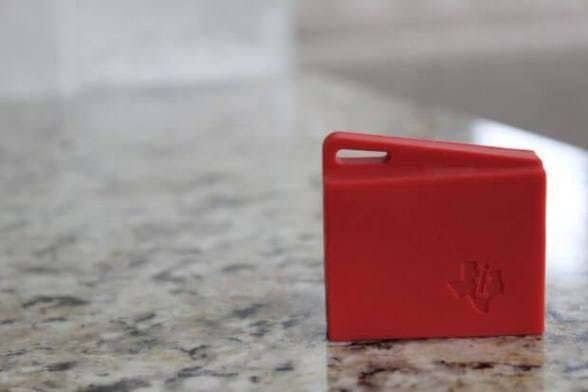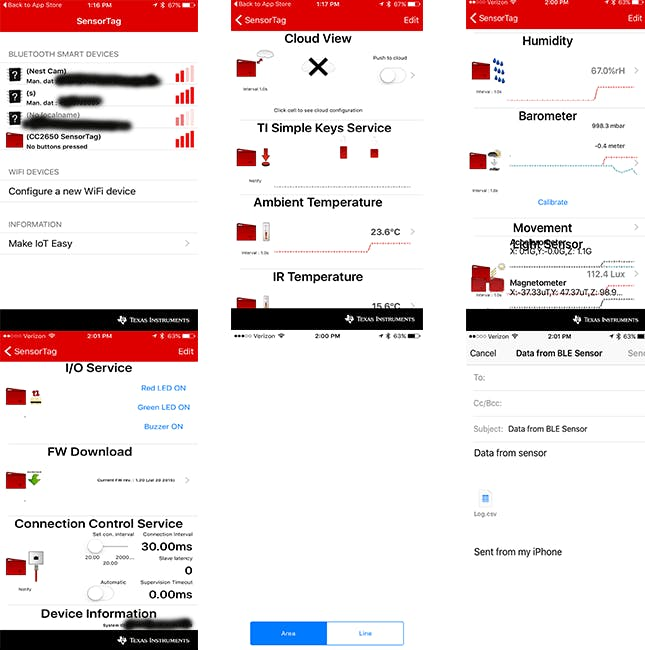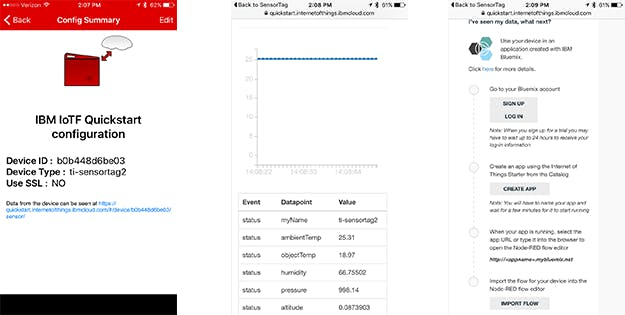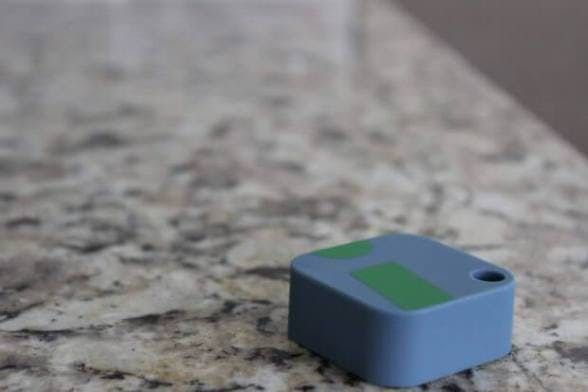
A Bluetooth temperature sensor seems a little dated. There are so many limitations tied to Bluetooth, and it certainly causes its fair share of frustrations. But there’s also a unique niche that Bluetooth fills. For those that want to monitor possessions in places where WiFi doesn’t reach, a Bluetooth temperature sensor may be the solution.
To find out which Bluetooth temp sensor is the best, we compared five and went hands-on with two (TI Texas Instruments SimpleLink™ SensorTag and SensorPush). After testing and researching, we recommend SensorPush.
BeeWi vs. TI SimpleLink™ vs. WeatherHawk myBlue vs. SensorPush vs. SensorBug Bluetooth Temperature Sensors
 |  |  |  |  | |
| BeeWi | SimpleLink™ SensorTag | WeatherHawk byBlue-T | SensorPush | SensorBug | |
| Bluetooth: | Bluetooth Smart | Bluetooth Smart | Bluetooth Smart | Bluetooth Smart | Bluetooth Smart |
| Distance: | up to 50m | up to 50m | up to 40m | up to 99m | up to 99m |
| Other: | Internet Compatible with Smart Gateway ($) | Wi-Fi (coming soon), Zigbee (separate device) | WiFi (coming soon, will require bridge $) | Remote Viewing via Browser (coming soon, will require IoTbridge home gateway $) | |
| Apps For: | iOS, Android, Windows Phone | iOS, Android, Computer with a CC2540 USB Dongle ($), and Third-Party Apps | iOS, Android | iOS, Android | iOS |
| Smartphone Alerts: | |||||
| Phone Alerts When Out of Range: | With Smart Gateway ($) Only | Unknown | With Bridge (Coming Soon) | ||
 |  |  |  |  | |
| BeeWi | SimpleLink™ SensorTag | WeatherHawk byBlue-T | SensorPush | SensorBug | |
| Batteries: | 2 AAA | Coin Cell | CR2032 Lithium Coin Cell | CR2477 | CR2032 |
| Battery Life: | 1 Year | 1 Year | 8 Months | 1 Year | 8 Months |
| Temperature Accuracy: | ±2°C | ±3°C | ±1°C | ±3°F | ±0.5°C |
| Humidity Accuracy: | ±4.5% | ±3°C | ±4.5% | ||
| Temperature Range: | -20°C to +85°C (-4°F to 185°F ) Range Limit | -40°C to +125°C | -20°C to +60°C (-4°F to 140°F ) | -20°C to +60°C (-4°F to 140°F ) | -55°C to +150°C |
| Other Sensors: | Barometer, Altimeter, 9-Axis Movement Sensor, Accelerometer, Gyroscope, Magnetometer, and Light Sensor | Vibration, Glass Break, Open/Close, Light, Accelerometer | |||
| App Data History: | 24 Hours | As long as you keep the app and sensor connected and running. | 2 Hours | 1 Year | |
| Device Storage: | Can hold data for 30 days. | Can hold data for 20 days. | |||
| Can be used outdoors? | Only if covered, not waterproof. | Only if covered, not waterproof. | |||
| Multiple Sensor Support: | |||||
| Where to Buy | Buy Here | Buy Here | Buy Here | Buy Here | Buy Here |
BeeWi Smart Temperature & Humidity Sensor
What makes the BeeWi sensor stand out among the rest is that it can work as a Bluetooth device, but can also provide data remotely via the internet, assuming you purchase an additional Gateway, and we weren’t able to find a Gateway for sale in the US. With a product line that is hard to find online, few reviews, and a solution that can be replicated using known and reputable makers (more on that later), we're calling BeeWi a pass. On the bright side, they did respond swiftly to our request for information.
Texas Instruments SimpleLink™ SensorTag

The T.I. SimpleLink™ SensorTag is one of the two sensors we tested. We selected this sensor because it is considerably different from the other options. It seemed like the sensor was aimed at developers and those looking to test and prototype IoT devices, not consumers, but with little information found online, we wanted to test it out for myself.
Texas Instruments makes different versions of the same sensor. They sell a Bluetooth Smart version (what we tested), the 6LoWPAN, a ZigBee device, and a Wi-Fi version (coming soon). The 6LoWPAN and ZigBee options have a longer range, extending from 150 feet to 300 feet via a mesh network. They also support more devices, and you can access the web using a BeagleBone gateway.
All of the sensors include mobile app access, but you also gain access to design files and open source software, created by other makers. As complicated as this all sounds, setting up the device is easy: download the app, remove the battery tab, select your SensorTag from the device list, and you’re good to go. Unfortunately, that is the only easy part.
Hands-On With Texas Instruments Bluetooth Temperature Sensor

If you are looking for a simple device to protect your expensive cigar collection or favorite instrument, this is not the sensor for you. It’s made more for developers and perhaps academic purposes than it is for end users. The interface is complex, not user-friendly, and glitchy. Plus, it lacks features that would make it useful.
- It can’t send notifications if temperature or humidity ranges fall out of line.
- It only reads in Celcius
- If you lose Bluetooth connection, you must reconnect the device to the app.
- There is no notification to let you know when you lose Bluetooth connection.
- Several screens within the app are blank and force you to restart the app.
- Restarting the app erases all collected data and any custom settings.
- The sensor cannot hold data and the app will only read data so long as your app session remains active.

All that said, there is an option to push data to the cloud. As a warning, this connection is not encrypted and it’s rather useless. We were hoping that pushing data to the cloud would cause it to log data and perhaps save it, but this didn’t happen. Each new cloud session erased old data and started a new log. You can email yourself data to save it, but that isn’t very helpful. The app also suggests signing up for an IBM Bluemix account, so we did, but signing up did not enhance the experience.
WeatherHawk myBlue-T Bluetooth Temperature Sensor
Setting itself apart, the myBlue-T is weatherproof, rated IP-67 (waterproof to 1 meter). And you can actually leave it in water, assuming you’ve purchased the floating lanyard accessory. On the downside, the reviews of this sensor are fairly middle of the road, with an average 3-star rating on Amazon. The reviews swayed us from purchasing myBlue-T, but they were not the only reason we didn’t buy this sensor for testing.
In addition to mediocre ratings, the device only has one sensor – temperature. Unfortunately, temperature isn’t a clear indicator of comfort. A 100-degree day in Florida feels different from a 100-degree day in Vegas. Finally, the app can only hold 2 hours of history. What good is that? And as a side note, the sensor itself can’t hold any data. So you will only receive all of the data if you are home 24/7 and within range of the device. We're calling Weatherhawk myBlue-T a pass.
All that said, after we did this review, Weatherhawk launched a new product that is more promising than their original device. The new product, myBlue-TH, provides temperature and humidity data and has a built-in logger. The myBlue-TH will log 250,000 data points, even when you are not within Bluetooth range. When you return, you can download all of the data that was recorded directly from the device to your phone. Though we haven't tested this particular device, we recommend it over myBlue-T.
SensorPush Wireless Thermometer / Hygrometer
Of all the options, the SensorPush was the only other device we think is worth a try. It currently has over a hundred reviews on Amazon with an average 4.5-star rating. Plus, on paper, it has potential. Our biggest initial concern over this device? The price. At $50, it is considerably more expensive than other sensors, without offering much more. What it does offer is local storage. One of the primary challenges with Bluetooth is that it only works when you are in range. If you are out of range, the data sits on the device, or it is deleted. With SensorPush, the device can hold data for 20 days, when you return, all of the held data is pushed to your phone.
Hands-On With Sensorpush

Setting up SensorPush was incredibly simple, and once it was setup, it's simple to use. The app is quick and intuitive, the data is easy to digest, and the sensor works. The app held collected data, the sensor automatically reconnected as we left and reentered Bluetooth range, and notifications to our smartphones were timely.
In addition to monitoring for humidity and temperature, the sensor claims an extraordinary range of 325 feet, and you can download data locally to a CSV file. When downloading to a CSV file, you can view time, temp, humidity and even any custom calibrations you’ve set.
The claim that you can stay connected when you have line of sight up to 325 feet seems a little wild for a Bluetooth device. Of course, more than likely, the sensor is going to be in a safe or an instrument case with walls between you. And with a steel door between us, we were able to maintain a connection at a distance of 175-200 feet. Pretty sweet.
SensorBug™ Low Profile Universal Wireless Sensor
SensorBug is for iOS users only, sorry everyone else. What makes it intriguing is that it is backed by multiple sensors (vibration, glass break, open/close, light, accelerometer). But with very few online reviews, the product seems a little too obscure. That said, it is still intriguing. The device appears to cater to the smart home crowd. They promise the ability to consolidate BlueSense smart home devices, and they say the device is iBeacon, AltBbeacon, or Eddystione configurable. But again, like Weatherhawk, we are missing a key element of any good temperature sensor – humidity. We're calling Sensor Bug a pass.
Bluetooth vs. WiFi Temperature Sensors
We’ve already talked about Bluetooth’s limitations. It only works within range, and unless you’re a hermit (nothing wrong with that), you aren’t always going to be within range. While some of the devices we talked about above can hold data until you get home, they can’t notify you of a problem while you are away. This is where Wi-Fi comes into play.
To connect a sensor to the internet, you need a hub. This works similarly to BeeWi, but there are other well-tested and well-known hubs already available. This list includes devices by SmartThings, Insteon, as well as hub-less devices like Point by Minut.
SmartThings
SmartThings is unique in that it can work in the cloud and locally. The system starts with a $99 hub, and you can grow your device list from there. Another cool thing about SmartThings is that many of their devices are multi-purpose. The downside is that their sensors are made to be used indoors, which may limit some applications.
SmartThings SmartSense Temp/Humidity Sensor – monitors for extreme temperatures (as set by you) and humidity levels. If the levels fall outside of your normal range, SmartThings will send an alert to your phone. Using IFTTT (duct tape for the internet of things), you can also setup phone call and email alerts. From SmartThings,
"Protect musical instruments, clothes, electronics, furniture, pieces of art, wine, and other household items that are vulnerable to extreme humidity levels."
SmartSense Multi Sensor – The Multi Sensor can monitor for open/close movement, vibration, orientation, angle, and temperature. It does not detect humidity.
SmartSense Moisture Sensor – This sensor is specifically for detecting leaks. If water is detected in your home, it will let you know. It also has a temperature sensor included to help prevent frozen pipes.
Insteon
Insteon requires a hub and internet access, but your “scenes” can work without the internet. Once you have that in place, you can connect it to multiple sensors.
Elgato 10027801 Eve Room Wireless Indoor Sensor – This sensor monitors for indoor air quality, temperature, and humidity.
Elgato 10027800 Eve Weather Wireless Outdoor Sensor – Unlike SmartThings, Insteon can connect to outdoor sensors. The Outdoor Sensor remotely monitors for temperature, humidity, and air pressure.
HomeSeer HSM200 Z-Wave Multi-Sensor – The Multi-Sensor detects motion, temperature, and light.
Point
Point is a single device that does not require an internet connection. The downside here is the size of the device. The device is about the size of a man’s palm and is meant to be wall mounted. As the device is still in its infancy, it lacks multiple promised features. Soon, it should be able to monitor for excesive noise, windows breasking, humidity, temperature, and even cigerette smoke. In addition to sending a notification to your phone, the device has an embeded LED light that can change colors based on what it detects.
Final Thoughts
There are certainly other devices that you can use to monitor for temperature and humidity including security cameras and professionally monitored alarm systems, but if you want a simple device to get the job done SensorPush is the winner.

